Background
The Masonic history of this Province is of course set within the wider development of Freemasonry in this country over the centuries. Students of Masonic history will be aware of the formation of Grand Lodges in the 18th Century and of the split between the ‘Ancients’ and the ‘Moderns.’
The first Grand Lodge, the Grand Lodge of England (GLE), was founded on 24 June 1717 and, because of the way they varied or modernised their ceremonies, members were known as the Moderns.
In 1753 the Grand Lodge of the Ancients was formed. This consisted of those who adhered to the traditional or ancient ceremonies and practices. Because the 3rd and 4th Dukes of Athol presided over them members were known as Athol Masons.
After difficult and protracted negotiations ‘Articles of Union’ unifying the two Grand Lodges were adopted on 27 December 1813. The United Grand Lodge of England (UGLE) was thereby formed. This remains the governing body of regular Freemasonry today.
Early Masonic History of Northamptonshire
A room in Canon's Ashby House near Daventry is believed to have been used as a Masonic Lodge Room around 1580-90. This is evidenced by symbols and paintings found in the room and other Masonic symbolism throughout the house.
In August 2010 WBro Kevin Corcoran of Eleanor Cross Lodge No 1764 conducted research to try and establish whether there is any provable basis for this connection but due to lack of evidence his findings are inconclusive (click here for a copy of the full research report).
The first provable record of a Lodge in Northamptonshire is of the George and Dragon Lodge No 62. The date of its warrant (or constitution as it was then known) was 16 January 1730. By 1740 the Lodge had become the St George and Dragon Lodge No 64. On 29 November 1754 it was erased.
The second Lodge was the Lodge of Harmony No 544 (later becoming No 453). Its warrant was dated 20 August 1789 and it met at the White Hart in the Drapery, Northampton. There is no record of the Lodge existing in Northampton after 1792. (It has no connection with the presently constituted Lodge of Harmony No 9048.)
An endorsement on its Constitution, dated 18 January 1806, declared that it had removed to the ‘Ship Tavern’ in the Borough of Boston, in the County of Lincoln. The same Lodge of Harmony (now) No 272 still meets in Boston, Lincolnshire. Its Brethrens’ application in 1906 for a Centenary Warrant failed because they were unable to show any record of working before 1806. The Lodge minutes for the short period it was held in Northampton were non existent.
WBro Clegg belonged to the Lodge. Most Masons will perhaps not be familiar with his name. They will, however, be familiar with “Hail Eternal by Whose Aid” and “Now the Evening Shadows Falling” both of which he wrote.
In 1798, the Province of Northamptonshire under the Earl of Pomfret as its first Provincial Grand Master was granted a Patent from the UGLE. As that Patent was being issued, the country celebrated Rear Admiral Nelson’s victory over the French Fleet at the Battle of the Nile in Aboukir Bay.
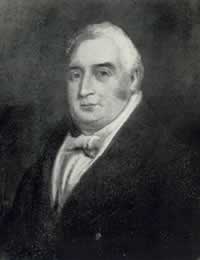
George Fermor, 3rd Earl of Pomfret, became first
Provincial Grand Master of Northamptonshire on 27 January, 1798
Local Masonry During the Napoleonic Wars
During the Napoleonic Wars (1793 to 1814) there were up to 122,000 enemy soldiers and sailors held in captivity in Prisoner of War camps around the UK. Most of them were held in rotten hulks on rivers as well as in City Goals.
French prisoners were held in Northampton. 6,000 were imprisoned at the Norman Cross Barracks near Peterborough. Several thousand were held at Weedon Barracks in Northamptonshire.
Many Masonic Lodges were formed by these prisoners. One such Lodge named La Bonne Union was in Northampton. The existence of this Lodge is known because its Master in 1810 was an honorary member of a Lodge in Ashby-de-la-Zouch, Leicestershire, called Vrais Amis de L'Odre. His name, as Master, appears on the two certificates of Bro Louis Jean described under the heading of the Lodge. Sadly no records have yet been found in Peterborough but it is known that many other Lodges existed throughout the British Isles.
Early Masonic History of Huntingdonshire
The first recorded Lodge in Huntingdonshire was Lodge No 160B. In 1802, it moved from Norwich to meet at the Angel Inn, Narrow Street, Peterborough. It had been originally warranted by the Grand Lodge of the Ancients on 3 September 1787 as Lodge No 160 meeting at the Golden Anchor, Norwich. In 1812 it moved from Peterborough to Pontypool as the Hiram Lodge. It was erased in 1830
Bro John Taylor Allison of the 2nd Battalion Northamptonshire Militia was a member of the Lodge of Perseverance No 213 which was originally warranted by the Grand Lodge of England (Moderns) and, to this day, meets in Norwich. He was a petitioner for Pomfret Lodge No 360 and its Secretary from 12 June 1821 to 19 September 1822.
It was warranted on 16 October 1819 and met in Northampton at the Fountain (later renamed the Criterion). Its eleven founders were drawn from the different Constitutions that existed before the formation of the United Grand Lodge of England (UGLE) in 1813. They had such widely differing views on procedure and the Lodge had little chance of survival. Helped by the newly formed UGLE they reached a measure of agreement, loosing two founders in the process. Attendances were small and it took many years for the Lodge to recover from these early setbacks. In 1836 there were only 13 members and they did not all attend regularly.
Freemasonry in Towcester began in 1837 with the formation of the Lodge of Fidelity which originally met at various public houses in Towcester including the Talbot, Saracens Head and Pomfret Arms.
In Kettering Freemasonry dates back to 1839 when the first meeting was held in the White Hart Inn (now the Royal Hotel).
First 100 Years of the Combined Province
In 1840, Northamptonshire combined with Huntingdonshire to form the Province of Northamptonshire and Huntingdonshire which continues to this day.
The Lodges existing at the time of this combination were
- Pomfret Lodge No 360 (Northampton)
- Socrates Lodge No 373 (Huntingdon)
- St Peter’s Lodge No 442 (Peterborough)
- Lodge of Fidelity No 445 (Towcester)
- Lodge of Perseverance No 455 (Kettering)
- Lodge of Merit No 466 (Stamford)
By 1840 the membership of Pomfret Lodge No 360 had increased to 61 but bad feeling still existed and the Lodge of Merit No 466 was formed in that year. A few years later it moved to Oundle and then to Stamford (where it still meets).
Although some members had misgivings about meetings taking place on licensed premises they continued to do so until 1875 when premises in Abington Street, Northampton were bought, rebuilt and converted into a Masonic Hall – all for £2,000.
Interest in Freemasonry then rapidly increased. Pomfret Lodge and its Royal Arch Chapter grew rapidly. In 1878 Eleanor Cross Lodge No 1764 was consecrated. The following year, Simon de St Liz Lodge of Mark Masons No 245 was formed. In 1881, De La Pre Lodge No 1911 was founded.
After only six years in their Abington Street Masonic Hall, Northampton brethren were finding it to be too small. They bought a site in Princes Street, Northampton for a new Masonic Hall. On 5 September 1889 a special Provincial Grand Lodge met at the Masonic Hall, Abington Street, Northampton for the purpose of laying the Foundation Stone of the new Masonic Hall. About 70 brethren heard the Provincial Secretary read the dispensation to wear Masonic clothing. They then adjourned to the garden of Beethoven House, Market Square, Northampton. From here, they paraded in procession to the Princes Street site where they were addressed by the RW Provincial Grand Master, the Earl of Euston, and others.
.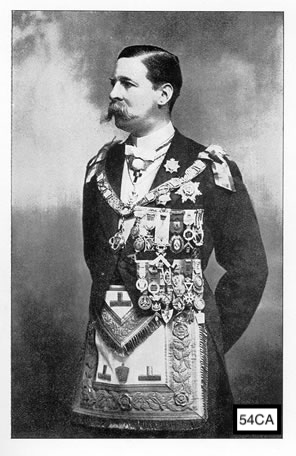
Rt Hon Henry James Fitzroy, Earl of Euston,
PGM, 1887 - 1912
The Provincial Grand Master then laid the Foundation Stone (which was to be later re-laid in St George's Avenue and in Sheaf Close, Northamton).
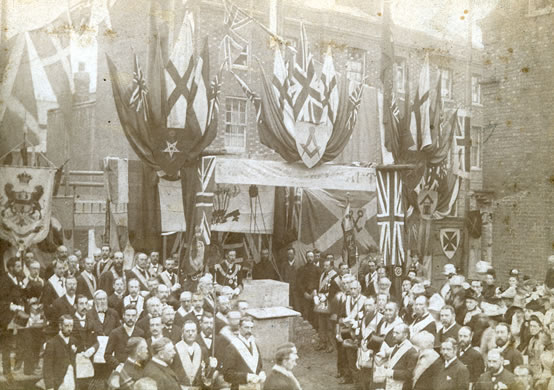
PGM, Earl of Euston, Laying Foundation Stone of Princes Street Masonic Hall, Northampton, 1889
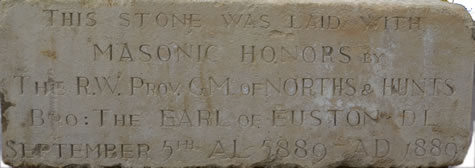
1889 Foundation Stone inscription
The trowel he used had Masonic connections through Pomfret Lodge:
- In 1836 it had been used by the Rt Honourable Earl Spencer to lay the Foundation Stone of the Northampton Lunatic Asylum
- In 1837 it had been used by the Most Noble the Marquess of Northampton to lay the First Stone of St Katherine’s Church, Northampton
- In 1840 it had been used by Sir Charles Knightley, Baronet, MP, to lay the Foundation Stone of St Andrew’s Church, Northampton
- In 1861 it had been used by the Rt Honourable John Poyntz, Earl Spencer, to lay the Corner Stone at St Giles’ Parochial Schools, Northampton
- In 1887 it had been used by HRH Prince Albert of Wales to lay the Foundation Stone of the Jubilee Wing of the Northampton General Hospital
Each of these events had been prominently attended by members of Pomfret Lodge.
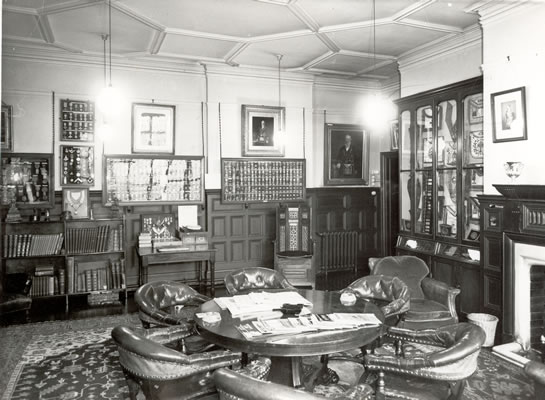
Library, Princes Street Masonic Hall, Northampton
In 1890 the Princes Street Masonic Hall was opened and the Provincial Grand Lodge met there for the first time. At that time there were three Lodges in Northampton.
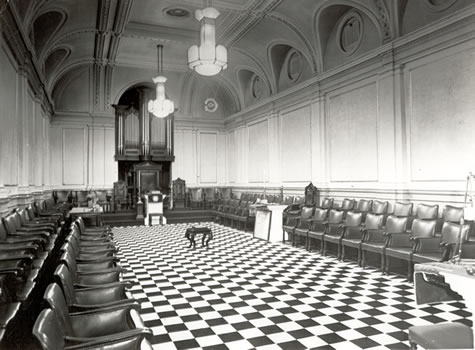
Lodge Room, Princes Street Masonic Hall, Northampton
As the end of the 19th Century approached, more Lodges were consecrated:
- In 1852 Chicheley Lodge No 607 (Thrapston)
- In 1858 Wentworth Lodge No 737 (Wellingborough)
- In 1878 Eleanor Cross Lodge No 1764 (Northampton)
- In 1881 De La Pre Lodge No 1911 (Northampton)
- In 1888 Euston Lodge No 2283 (Eaton Socon)
- In 1891 Beneventa Lodge No 2380 (Daventry)
- In 1892 Kingsley Lodge No 2431 (Northampton)
- In 1895 Fitzwilliam Lodge No 2533 (Peterborough)
- In 1895 England’s Centre Lodge No 2555 (originally Weedon - moved to Northampton in 1949)
- In 1897 St Ivo Lodge No 2684 (St Ives)
By the outbreak of the First World War in 1914 a further six Lodges had been consecrated.Although Stamford is in the County of Lincolnshire, the 1913 Provincial Grand Lodge of the Province of Northamptonshire and Huntingdonshire was held there after a dispensation had been granted by the Provincial Grand Master of Lincolnshire, the Rt Hon Lord Yarborough. The need for such dispensation for future events was rendered unnecessary after a 1919 letter to our Provincial Grand Master, the Rt Hon Lord Lilford from Lord Yarborough. He stated that, henceforth, for Masonic purposes, the whole of the town of Stamford should be considered to be in our Province. This has remained so ever since.
During the Great War 119 Brethren of the Province (about 10% of the total membership) served King and Country. It was suggested at the Provincial Grand Lodge of 1915 that a Roll of Honour of those who laid down their lives be kept but this was not done.
Grand Lodge issued a Masonic prayer for use in time of war. Some Lodges in the Province issued a War Card with a prayer for Brethren on active service. This was printed in the languages of the five warring nations (English, French, German, Italian and Turkish).
Between the First and Second World Wars ten Lodges were consecrated.
Because of the emergency created by the Second World War many of the activities associated with Freemasonry were temporarily curtailed. These included restrictions on meeting days and times, suspension of the traditional Festive Board and the short notice cancellation of Lodge meetings.
The Later Half of the 20th Century
On 5 April In 1954 WBros Fredrick Snelson, Henry Ivens and William Roper signed a contract with Right Honourable Baron Fredrick Hesketh & Major Fermor Hesketh leasing the ground on which now stands the Towcester Masonic Hall. The lease was for 99 years and the cost ten shillings a year. (Lord Thomas Hesketh was PGM from 1936 to 1944. His grandson, Lord Alexander Hesketh, is still a member of the Lodge of Fidelity. )
The last meeting for Freemasonry in Northampton in Princes Street Masonic Hall (of Kingsley Lodge No 2431) was in 1972. The growth in the strength of Freemasonry in Northampton can be gauged by the fact that it had become the home of fourteen Lodges (from three when it opened in 1890).
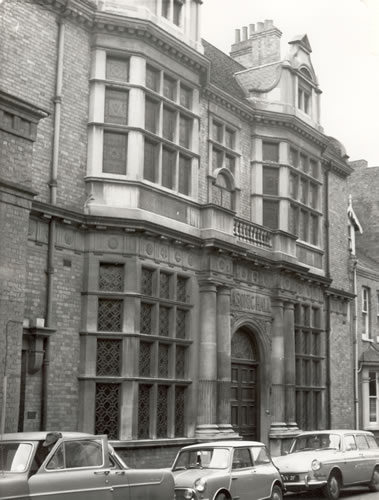
Princes Street Masonic Hall, Northampton, 1969
This growth meant the building had become grossly inadequate. An appeal was launched by the Provincial Grand Master, RWBro Richard Palmer, OBE, TD, DL. A site in St George’s Avenue, Northampton, was subsequently purchased from Northampton Borough Council and the present Freemasons’ Hall built. On 23 July 1971 the MW Bro The Honourable The Earl Cadogan MC DL, Pro Grand Master, laid the Foundation Stone.
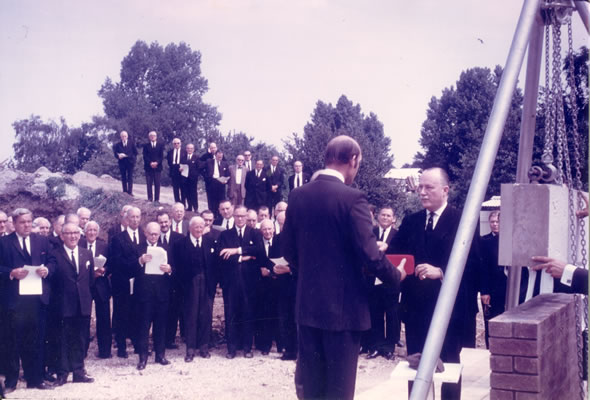
MW Bro The Honourable The Earl Cadogan MC DL, Pro Grand Master,
with PGM, RWBro Richard Palmer laying Foundation Stone,
Freemasons’ Hall, St George’s Avenue, Northampton
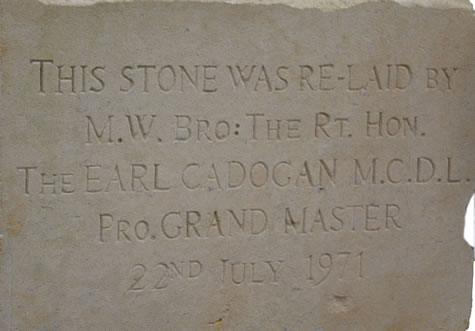
Foundation Stone inscription added in 1971
At a Benevolence Committee Meeting in November 1971 the Provincial Grand Master introduced a new concept of the role he wished Provincial Grand Stewards to play. He stated that he intended to appoint four Provincial Grand Stewards each year from the Masters who had recently vacated the Chair and that they would continue to hold that rank until eligible for promotion.
Accordingly, at the Provincial Grand Lodge of May, 1972, he appointed the first four of these new style Provincial Grand Stewards. Amongst them was WBro Brian Smith who was destined to be Provincial Grand Master from 1990 to 1997.
The Most Honourable the Marquess of Northampton DL was initiated into the Ceres Lodge No 6977 in this Province on the 8 December 1976, appointed Deputy Grand Director of Ceremonies in April 1983 and invested as Assistant Provincial Grand Master in May of the same year. In 2001, after 6 years as Assistant Grand Master, he was appointed Pro Grand Master, an appointment of which the Province is very proud.
The Province’s first Provincial Grand Master, George, 3rd Earl of Pomfret was the Great Great Grandfather of our 9th Provincial Grand Master, Thomas, Lord Hesketh who died in 1944. The family tradition was continued in the person of Thomas Alexander, Lord Hesketh, a member of the Lodge of Fidelity No 445 which meets at Towcester, Northamptonshire.
Into the 21st Century
As the new Millennium dawned on 1 January 2000 there were 83 Lodges in the Province. An emerging theme has been the consecration of special interest Lodges:
- in 2001 Webb Ellis Lodge No 9740 (Wellingborough) for those with an interest in Rugby Union Football
- in 2004 Grand Junction Lodge No 9775 (Stoke Bruerne) for those with an interest in canals and canal boats
- in 2005 Graham Milton Lodge No 9796 (Thrapston) for those with an interest in motor cycling
- in 2005 Nantahala Lodge No 9805 (Peterborough) for those wishing to attend a daytime Lodge
- in 2005 Scout Lodge No 9814 (Wellingborough) for those with scouting connections
- in 2007 Wilavestone Lodge No 9829 (Wollaston) for those with connections with the the village of Wollaston
- in 2010 Salcey Forest Lodge No 9854 (Hackleton) for those with busy working lives and restricted time for their Freemasonry
In 2007, in a shrewd business move, Towcester Masonic Hall sold the Car Park next to the Hall. With the proceeds they bought additional land adjacent to the Masonic Hall. This land was used to extend and develop the Hall, doubling the Hall's size to cope with the future demands of Freemasonry in the expanding Towcester area. The North East Corner Stone laying ceremony took place on Friday, 27 April 2012, when the stone was laid by one of the most senior Towcester members, WBro Roy Humphrey, and the PGM, RWBro Max Bayes.
In 2012 the home of Northampton Masonry for 40 years (in St George's Avenue) was sold and the premises vacated on 31 May. From the beginning of the 2012/13 Masonic season the temporary meeting place for Northampton Lodges was the Westone Manor Hotel, Ashley Way, Weston Favell, Northampton.
Final Video Tour of Former Masonic Hall, St George's Avenue, Northampton
Provincial Grand Masters
- 1798 George, 3rd Earl of Pomfret (Northamptonshire only)
- 1796 Lord Eardley (Huntingdonshire only - with Cambridgeshire until 1840)
- 1800 Arthur, 1st Earl of Mount-Norris (Huntingdonshire only)
- 1825 Rev George Adam Browne
- 6th March 1840 Earl of Aboyne (later to succeed to the title as Charles 10th Marquess of Huntley) Province of Northamptonshire and Huntingdonshire created
- 24th Oct 1863 William, 7th Duke of Manchester, KP
- 13th July 1887 Henry James Fitzroy, Earl of Euston
- 19th July 1912 John, 5th Lord Lilford
- 4th Nov 1936 Thomas, Lord Hesketh
- 1st Nov 1944 Evan Harries-Jones, MD
- 25th July 1951 Edward Elgar Field, OBE, PhD
- 21st Nov 1962 Bertram Guillaume
- 10th Feb 1971 Richard Augustus Palmer, OBE, TD, DL
- 17th Apr 1984 Richard Stainton Edward Sandbach, MA, LLM
- 16th July 1990 Howard Brian Smith
- 1st July 1997 Oliver Nicolas Norwood Hart
- 1st July 2005 William Barrington Hall
- 27th July 2011 Maxwell William Bayes
- 27th July 2022 Mark Robert Constant
Deputy Provincial Grand Masters
- 1842 Thomas Ewart
- 1863 Henry Porter
- 1869 Samuel Inns
- 1875 Butler Wilkins
- 1895 John Halivand
- 1904 Harry Manfield
- 1915 Thomas Horton
- 1924 George F. E. Wilkinson
- 1933 Evan Harries-Jones MD
- 1945 Edward Elgar Field OBE PhD
- 1952 Edward Chandler Gravestock
- 1954 Bertram Guillaume
- 1963 Richard Augustus Palmer OBE TD DL
- 1971 Dennis Roy Baker
- 1978 Richard Stainton Edward Sandbach
- 1984 Howard Brian Smith
- 1990 David Manners
- 1994 Oliver Nicolas Norwood Hart
- 1997 Eric Michael Pell
- 2000 William Barrington Hall
- 2005 Derek George Young
- 2007 Maxwell William Bayes
- 2011 Vivian Thomas
- 2015 Trevor Boswell
- 2018 Charles Bennett
- 2024 Tim Almond
Assistant Provincial Grand Masters
- 1974 Richard Stainton Edward Sandbach
- 1978 Sidney Ronald Fox
- 1983 The Marquess of Northampton
- 1985 George Percival Thomas Briggs
- 1988 David Manners
- 1990 Oliver Nicolas Norwood Hart
- 1994 Eric Michael Pell
- 1994 Donald Frederick White
- 1997 William Barrington Hall
- 2000 Norman Denis Coulson
- 2000 Frederick Donald Dunk
- 2003 Derek George Young
- 2004 Maxwell William Bayes
- 2005 Wayne Edward Williams
- 2007 Vivian Thomas
- 2011 Norman Pope
- 2012 Jim Boughton
- 2015 David Burton
- 2016 Charles Bennett
- 2018 Luigi Orsi
- 2019 Mark Robert Constant
- 2022 Michael Charles Alexander Caseman-Jones TD
- 2022 Timothy Joseph Almond
- 2024 Dale Robert Gilbert
- 2024 Francis Edward Margôt
Postscript
In this short account we have attempted to give a flavour of the history of the Province of Northamptonshire and Huntingdonshire. At this point in our evolution history begins to overlap with news.
More recent happenings in the Province are regularly reported and available from various sources including Password, the Provincial magazine, and the News part of this web site.
We commend to you both these sources of information and the those used to research the historical information reproduced here.
Sources
- "A History of the Provincial Grand Lodge of Norths And Hunts” by Thomas Phipps Dorman PM 1764, 2228, PProvSGW, Norths and Hunts, published by Bro JW Stanton, Northampton, 1912
- “£200,000 Appeal” (appeal booklet for the New Masonic Hall) published by the Province of Northamptonshire and Huntingdonshire,1969
- “The History of the Masonic Province of Northamptonshire and Huntingdonshire, Volume 2, 1912-1998” by the late WBro WA Wright, PAGDC, PProvSGW, published by the Province of Northamptonshire and Huntingdonshire, 1997
- the former Masonic Library at Freemasons’ Hall, Sty George's Avenue, Northampton and its Librarian, the late WBro Ray Turner
- This history researched and compiled by WBro Gerry Crawford in 2007 and subsequently update by him
